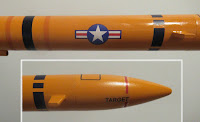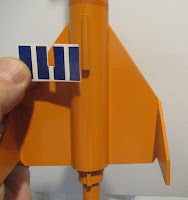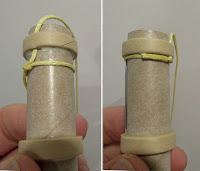I wrapped a strip of tape to have a consistent line for the rear edge of the fins.
The picture on the right shows how the fin will sit. After glue is lightly applied to the root edge, start the fin on the body at the rear corner and pivot turn the root edge down onto the alignment line.
I used the acetone based Fabri-Tac glue to initially tack the fins in place. The Fabri-Tac gives you some working time if you need to adjust the fins before it sets up.
Glue the opposite fin on. Sight across the back end to be sure they are in line.
After the Fabri-Tac dries, I used some medium CA glue to lock the fins to the body tube.
After the Fabri-Tac dries, I used some medium CA glue to lock the fins to the body tube.
Squeeze out a drop of CA glue onto some scrap cardboard. Dip a toothpick tip into the glue, you don't need big drop of glue. A little CA goes a long way.
Draw the toothpick tip down the root edge of the fin/body tube joint making a fillet.
Immediately pick up any excess glue with a swipe of a Q-tip.


















































